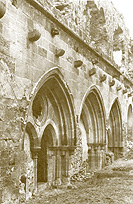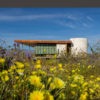In 1181, at the request of King Alfonso VIII of Castile, Cistercian monks arrived in Trillo, Guadalajara, a town some 80 miles northeast of Madrid, Spain, to establish the Abbey of Santa Maria de Ovila. It was to function as a permanent establishment in a chain of outposts that would help settle and maintain the territory that Alfonso had recently reconquered from the Moors. The monks lived at Ovila for more than 600 years, until a decree of the government of Maria Christina suppressed all small monasteries around 1835. Sold to a wealthy family, the abbey eventually fell into disrepair while used as sundry farm buildings.
In 1931, William Randolph Hearst purchased parts of Ovila, including the entire Chapter House—which was constructed between 1190 and 1220—dismantled the stones, and shipped them to the United States. Hearst intended to use the stones to construct a swimming pool and bowling alley at his Wyntoon Castle on the McCloud River in Northern California. Financial problems led him instead to donate the stones to the City of San Francisco in return for a cancelled debt. The City moved the stones to Golden Gate Park, where they fell victim to a series of fires, theft, and vandalism that destroyed the identifying numbers that provided the code to reconstruct the Chapter House.
The Abbey of New Clairvaux, a community of Trappist-Cistercian monks living in the fertile Sacramento Valley of Northern California, acquired the Chapter House stones in 1994, after more than thirty years of attempts.
Master stonemason Oskar Kempf and his associate, Ross Leuthard, have surveyed the stones and are using computer imaging to determine their placement. They will refurbish existing stones, test them for strength, and carve the missing stones. Patrick Cole, principal architect, is preparing the site master plan, design development drawings and outline specifications for the Chapter House, cloisters and new Abbey Church. Soroush Gharhamani is the project manager for the Chapter House restoration, with Carl F. Meyer as consulting architect. Phil Sunseri of the Sunseri Associates, Inc., Chico/Sacramento, is preparing to undertake the reconstruction.
The Chapter House will be reassembled according to strict ratios of Cistercian architecture. Once rebuilt, the Santa Maria de Ovila Chapter House will be the oldest freestanding building west of New York, and one of only three examples of Cistercian Gothic architecture in the United States. By agreement with the Fine Arts Museums of San Francisco, the Chapter House and an archival library will be open to the public, free of charge, during specified hours.
Originally published 2nd quarter 2004 in arcCA 04.2, “Small Towns.”







